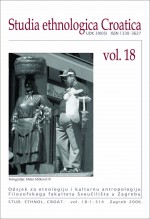Dalmatinska narodna umjetnost u Austro-Ugarskoj monarhiji početkom 20. stoljeća
Dalmatian Folk Art in Austro-Hungarian Monarchy at the Beginning of the 20th Century
Author(s): Branka Vojnović-TraživukSubject(s): Fine Arts / Performing Arts, Customs / Folklore, Ethnohistory, Cultural Anthropology / Ethnology, Pre-WW I & WW I (1900 -1919)
Published by: Sveučilište u Zagrebu, Filozofski fakultet
Keywords: folk art; Dalmatia; Austro–Hungarian Monarchy;
Summary/Abstract: The paper examines the Austrian interest in the folk artistic expression in Dalmatia. The most important was the book Dalmatien und seine Volkskunst published in German in 1910. and in Croatian in 1912. The author was an Austrian collector Natalie Bruck Auffenberg, who was travelling across Dalmatia, and collecting many things on the spot. The concept of Dalmatian folk art was established at the beginning of the 20th century under the protectorate of the Archduchess Maria Josepha. It was a part of Austro-Hungarian official interpretation of history and culture with the united Monarchy as the central idea. The folk art was understood as an archaic form of great art, in accordance with aesthetic ideals of the middle class. It was evaluated as a primitive artistic expression without great influences of the western art, so it corresponded with some Secession tendencies. These Central European influences contributed to processes of cultural modernization in Dalmatia. The local intellectuals became aware of the significance of the traditional culture and began to protect folk art as national treasure. These ideas were dominant in the activities of the Architectural, Arts and Crafts School (Graditeljska, zanatlijska i umjetnička škola) and the Regional Museum of Folk Arts and Crafts (Pokrajinski muzej za narodni obrt i umjetnost) in Split. Kamilo Tončić, who graduated from Technical College in Vienna, was the founder of both institutions. The leading functions of the new institutions in Split were artistic education and conservation of folk art as well as linking up with the rising tourism. So, the recognition of the folk artistic expression in Dalmatia reached a peak in the period before the First World War.
Journal: Studia ethnologica Croatica
- Issue Year: 2006
- Issue No: 18
- Page Range: 281-298
- Page Count: 18
- Language: Croatian

